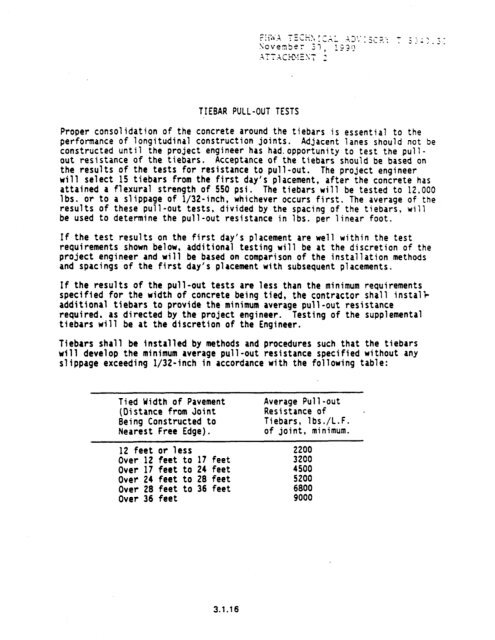chapter 3 rigid pavement - DOT On-Line Publications - Department ...
chapter 3 rigid pavement - DOT On-Line Publications - Department ...
chapter 3 rigid pavement - DOT On-Line Publications - Department ...
Create successful ePaper yourself
Turn your PDF publications into a flip-book with our unique Google optimized e-Paper software.
TIEBAR PULL-OUT TESTS<br />
Proper consolidation of the concrete around the tiebars is essential to the<br />
performance of longitudinal construction joints. Adjacent lanes should not be<br />
constructed until the project engineer has had.opportunity to test the pull-<br />
out resistance of the tiebars. Acceptance of the tiebats should be based on<br />
the results of the tests for resistance to pull-out. The project engineer<br />
will select 15 tiebars from the first day's placement, after the concrete has<br />
attained a flexural strength of 550 psi. The tiebars will be tested to 12,000<br />
lbs. or to a slippage of l/32-inch, whichever occurs first. The average of the<br />
results of these pull-out tests, divided by the spacing of the tiebars, will<br />
be used to determine the pull-out resistance in lbs. per linear foot.<br />
If the test results on the first day's placement are well within the test<br />
requirements shown below, additional testing will be at the discretion of the<br />
project engineer and will be based on comparison of the installation methods<br />
and spacings of the first day's placement with subsequent placements.<br />
If the results of the pull-out tests are less than the minimum requirements<br />
specified for the width of concrete being tied, the contractor shall instalk<br />
additional tiebars to provide the minimum average pull-out resistance<br />
required, as directed by the project engineer. Testing of the supplemental<br />
tiebars will be at the discretion of the Engineer.<br />
Tiebars shall be installed by methods and procedures such that the tiebars<br />
will develop the minimum average pull-out resistance specified without any<br />
slippage exceeding l/32-inch in accordance with the following table:<br />
Tied Width of Pavement<br />
(Distance from Joint<br />
Being Constructed to<br />
Nearest Free Edge).<br />
12 feet or less 2200<br />
Over 12 feet to 17 feet 3200<br />
Over 17 feet to 24 feet 4500<br />
Over 24 feet to 20 feet 5200<br />
Over 28 feet to 36 feet 6800<br />
Over 36 feet 9000<br />
3.1.16<br />
Average Pull-out<br />
Resistance of<br />
Tiebars, lbs./L.F. .<br />
of joint, minimum.
















